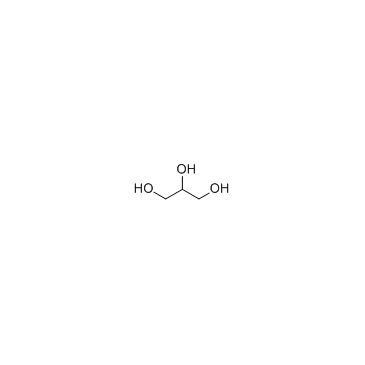Glycerol |
| Catalog No.GC36158 |
Glycerol is used in sample preparation and gel formation for polyacrylamide gel electrophoresis.
Products are for research use only. Not for human use. We do not sell to patients.

Cas No.: 56-81-5
Sample solution is provided at 25 µL, 10mM.
Glycerol is a clear, colourless, viscous, sweet-tasting liquid. Glycerol is used in sample preparation and gel formation for polyacrylamide gel electrophoresis. Human Endogenous Metabolite
Glycerol is often included in polyacrylamide gels to prevent dissociation of nucleosomes and other protein-DNA complexes during electrophoresis. With glycerol included, fractionation seems to be largely based on particle mass and charge. The concentration of glycerol during electrophoresis strongly affects the separation characteristics of polyacrylamide gels[1]. Glycerol is an inevitable by-product of oils/fats processing, regardless of the pathway. Fermentative metabolism of glycerol has been studied in great detail in several species of the Enterobacteriaceae family, such as Citrobacter freundii and Klebsiella pneumoniae. The use of anaerobic fermentation to convert abundant and low-priced glycerol streams generated in the production of biodiesel into higher value products represents a promising route to achieve economic viability in the biofuels industry[2].
Glycerol can induce acute renal failure in rat models. Acute renal failure induced by glycerol or uranyl nitrate reduces the hepato-biliary transport of some drugs, modulates the distribution of drugs into the central nervous system and affects the activity of various hepatic microsomal enzymes [3].
[1]. Pennings S, et al. Effect of glycerol on the separation of nucleosomes and bent DNA in low ionic strengthpolyacrylamide gel electrophoresis. Nucleic Acids Res. 1992 Dec 25;20(24):6667-72. [2]. Yazdani SS, et al. Anaerobic fermentation of glycerol: a path to economic viability for the biofuelsindustry. Curr Opin Biotechnol. 2007 Jun;18(3):213-9. [3]. Huang ZH, et al. Expression and function of P-glycoprotein in rats with glycerol-induced acute renal failure. Eur J Pharmacol. 2000 Oct 20;406(3):453-60.
Average Rating: 5 (Based on Reviews and 5 reference(s) in Google Scholar.)
GLPBIO products are for RESEARCH USE ONLY. Please make sure your review or question is research based.
Required fields are marked with *




















